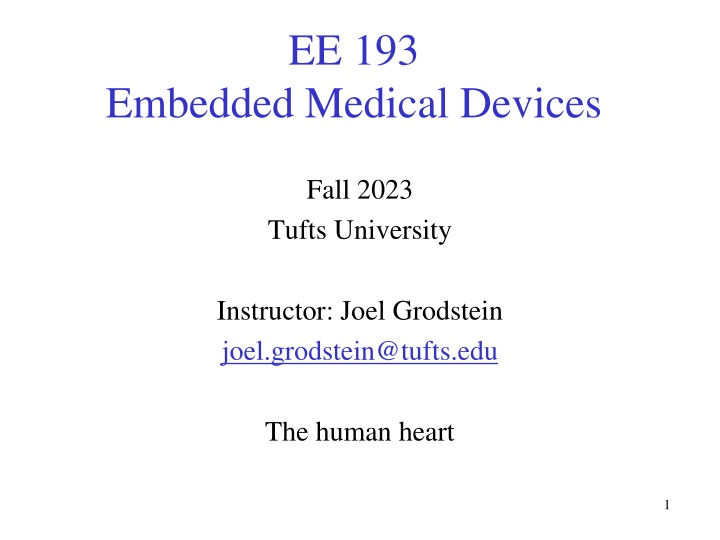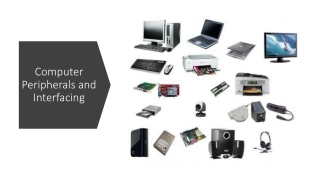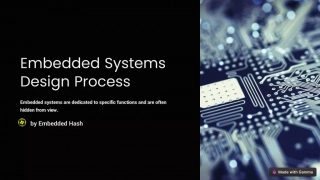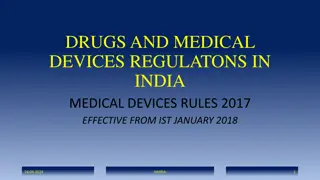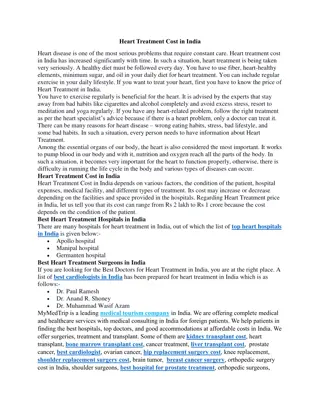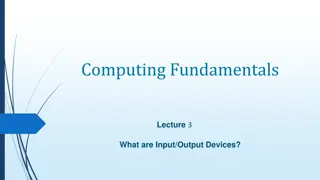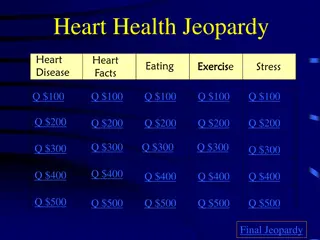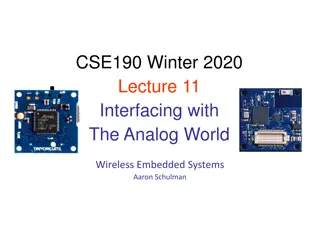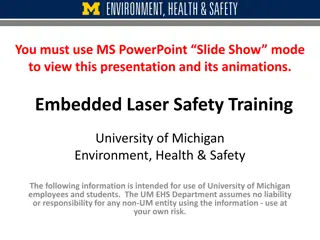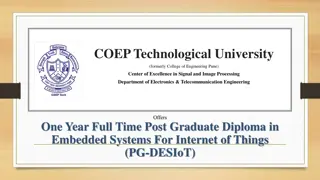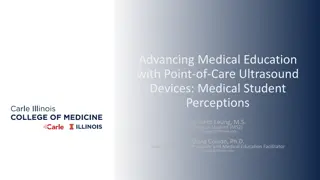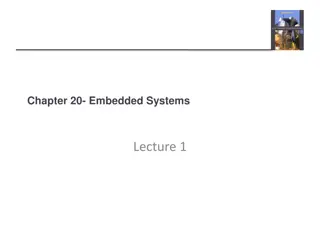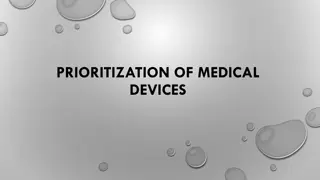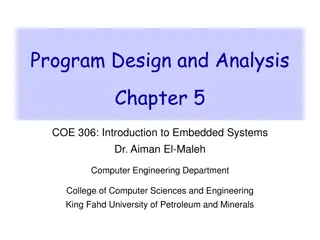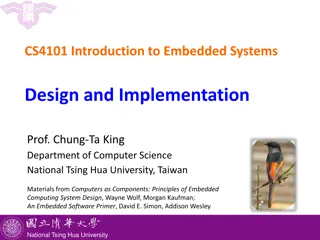Embedded Medical Devices - Understanding the Human Heart
Dive into the fascinating world of embedded medical devices with a focus on the intricate workings of the human heart. Explore cardiac facts, ECG measurement, heart disease statistics, and the engineering marvel that is the mammalian heart. Discover the complexities of heart attacks, cardiac arrests, and the robust fail-safe systems that keep the heart beating. Uncover historical insights and scientific breakthroughs related to the heart's functions and origins.
Download Presentation

Please find below an Image/Link to download the presentation.
The content on the website is provided AS IS for your information and personal use only. It may not be sold, licensed, or shared on other websites without obtaining consent from the author.If you encounter any issues during the download, it is possible that the publisher has removed the file from their server.
You are allowed to download the files provided on this website for personal or commercial use, subject to the condition that they are used lawfully. All files are the property of their respective owners.
The content on the website is provided AS IS for your information and personal use only. It may not be sold, licensed, or shared on other websites without obtaining consent from the author.
E N D
Presentation Transcript
EE 193 Embedded Medical Devices Fall 2023 Tufts University Instructor: Joel Grodstein joel.grodstein@tufts.edu The human heart 1
Table of contents Cool cardiac facts & why we care Cardiac basic operation Electrocardiograms Arrhythmias Backup-system engineering 2 to 3 billion cells; they break and die all the time 2 EE 123 -- Bioelectricity
Why do we care? The next few labs will be measuring our ECG Heart disease is the #1 killer in the U.S. The mammalian heart is a super cool, well- engineered system 3 EE 123 -- Bioelectricity
Deaths/year in U.S. 2.8M deaths/year total (.9 / 100 people) Heart disease = 650K Cancer = 600K Coronavirus = 188K (9/6/2020) Accidents = 170K Chronic lower respiratory diseases: 160K Stroke = 150K Alzheimer s = 120K Diabetes = 80K Mostly heart attacks (from https://www.cdc.gov/nchs/products/databriefs/db328.htm) 4 EE 123 -- Bioelectricity
Heart attack = blocked artery starves heart muscle Plumbing problem Heart dies over hours to weeks Cardiac arrest = heart stops beating Electrical problem Lose consciousness in seconds; die in minutes 530K cases/year; 8% survival rate CPR, AED save lives PSA learn how to use one! one cause 5 EE 123 -- Bioelectricity
A miracle of engineering The heart contains 2-3 billion independent cells Cells have high variability Cells are quite failure prone They somehow link together to produce a coordinated, durable, and adaptable whole! The heart is really really really robust a miracle of fail-safe engineering Multiple backup subsystems It s really robust! Keeps beating and never stops Except for the 99 varieties of heart disease 6 EE 123 -- Bioelectricity
Galen of Pergamum, 130-200AD extracted heart keeps beating for a long period nobody knew why Question: does your heartbeat originate in the brain and get sent to the heart via neurons? Keith and Flack (1907) sinoatrial node initiates the heartbeat 7 EN1 123-- Bioelectricity
Table of contents this unit Cool cardiac facts & why we care Cardiac basic operation Electrocardiograms Arrhythmias Backup-system engineering 8 EE 123 -- Bioelectricity
Plumbing the big picture Two separate two-chambered pumps Red = oxygenated Blue = not Two chambers = more efficient 9 EE 123 Bioelectricity
What does electricity do? Electricity drives the muscles Muscles drive the plumbing Similar to the rest of your body 10 EE 123 Bioelectricity
The pumps in operation https://www.youtube.com/watch?v=CWFyxn0qD EU Mayo Clinic https://www.youtube.com/watch?v=-s5iCoCaofc Suitable for younger than college age 11 EE 123 -- Bioelectricity
Atrial conduction Sinoatrial (SA) node is the oscillator Signal spreads over the atria at 1 m/s (100ms total) Atrial muscles contract SA 12 EE 123 -- Bioelectricity
Conduction on the highways Through the AV node (slowly) Zoom through the bundle of HIS, left/right bundle branches SA AV 13 EE 123 -- Bioelectricity
Conduction on the highways Then the Purkinje fibers SA AV 14 EE 123 -- Bioelectricity
Ventricular conduction Purkinje fibers have seeded the AP on much of the ventricular surface Now it squeezes the entire muscle all at once SA AV 15 EE 123 -- Bioelectricity
Entrainment Sinoatrial node has 500K cells Each one oscillates independently Potentially a slightly different frequency, phase How can your heart have a single unified beat? Entrainment is the process of all the oscillators talking to each other and agreeing on a frequency Now it has a name But how does it work? 16 EE 123 -- Bioelectricity
Gap junctions A gap junction (GJ) is a little tube that connects two cells GJs allow cells to talk to each other Molecules can travel between the two cells A resistor between two cells Interesting tidbit it s a voltage-controlled conductance Tie oscillators together force them to sync up +10mV Na+ Cl- Na+ -20mV Cl- 17 Bioelectricity Joel Grodstein
Mini-quiz What does plumbing vs electrical mean? What is a GJ? 18 EE 123 -- Bioelectricity
Table of contents Cool cardiac facts & why we care Cardiac basic operation Electrocardiograms Arrhythmias Backup-system engineering 19 EE 123 -- Bioelectricity
What is an ECG? Measures the heart s summed action potential Each AP in the cardiac wave small current travels through the body to the ECG electrodes Different heart cells are oriented in different directions; vector dot products cause different results depending on where electrodes are attached 20 EE 123 -- Bioelectricity
Atrial conduction P wave = atrium firing SA AV R T P Q S 21 EE 123 -- Bioelectricity
Ventricular conduction Purkinje fibers have seeded the AP on much of the ventricular surface Now it squeezes the entire muscle all at once Why is QRS complex taller & skinnier than the P wave? R SA AV T P Q S 22 EE 123 -- Bioelectricity
Ventricular recovery Ventricular recovery It takes current to recover from firing, too T wave SA AV R T P Q S 23 EE 123 -- Bioelectricity
Electrocardiogram R T P Q S How can you read these delays? heartrate time to traverse atria + AV node time to traverse AV node total ventricular firing + recovery Locate these SA node firing atrial firing atrial recovery ventricular firing ventricular recovery 24 EE 123 -- Bioelectricity
Table of contents this unit Cool cardiac facts & why we care Cardiac basic operation Electrocardiograms Arrhythmias so many things can go wrong Backup-system engineering 25 EE 123 -- Bioelectricity
Atrial conduction review Sinoatrial (SA) node is the oscillator Signal spreads over the atria at 1 m/s (100ms total) Atrial muscles contract SA AV 26 EE 123 -- Bioelectricity
Your heart, on AFib Loop starts at an ectopic pacemaker Goes round and round with no input from SA node Called a reentrant arrhythmia May take a slightly different path each time Waves spread out from the loop, some go through AV node and trigger ventricles SA AV 27 EE 123 -- Bioelectricity
Atrial fibrillation R T P Q S No P wave why? HR is irregular why? Frequency usually about 150 bpm Ventricles pumping inefficiently but still pumping why? You can limp to the phone to call 911 Lookahead we ll talk about another backup system shortly 28 EE 123 -- Bioelectricity
https://watchlearnlive.heart.org/i ndex.php?moduleSelect=atrfib Traditionally requires a one-way path 29 EE 123 -- Bioelectricity
Atrial fib causes Causes: Congenital heart disease of many types Sedentary lifestyle (via diabetes, obesity, high blood pressure) Excessive endurance exercise! Exercise is a powerful drug, with a dose/response curve Cures Various drugs Ablation Rest, sleep or time 30 EE 123 -- Bioelectricity
Ablation Find the ectopic pacemaker Surgically break the loop SA AV 31 EE 123 -- Bioelectricity
Ablation Find the ectopic pacemaker Surgically break the loop Either burn or freeze the relevant heart tissue SA AV 32 EE 123 -- Bioelectricity
Ablation Find the ectopic pacemaker Surgically break the loop Either burn or freeze the relevant heart tissue Like any procedure, it s not risk free Atrial fib: surgery or not? https://www.medscape.com/viewartic le/919228 https://www.drjohnm.org/2011/03/the -best-tool-for-treating-atrial- fibrillation Anyone have an interesting story? SA AV 33 EE 123 -- Bioelectricity
Bundle-branch block What it is delay or blockage in left or right BB Symptoms None (majority case) Fainting, dizzyness Causes Prior heart attack, bacterial infection, high blood pressure, Genetic Too much exercise Consequences often none (explanation shortly) SA AV 34 EE 123 -- Bioelectricity
RBBB example Diagnosis: wide QRS complex .1-.12s partial block (not uncommon, especially in endurance athletes) >.12s complete block (less common) Is this ECG normal, partial RBBB or complete? 35 EE 123 -- Bioelectricity
RBBB not a big problem The RBBB is mine! Any reason I m still alive (and not overly concerned)? Heart cells are quite interconnected Left branch crosses over to drive the right side Right side is just the lungs anyway SA AV 36 EE 123 -- Bioelectricity
Group exercise Why does RBBB cause wide QRS? Would you expect a left BBB to be more dangerous than right, or less? 37 EE 123 -- Bioelectricity
Table of contents this unit Cool cardiac facts & why we care Cardiac basic operation Electrocardiograms Arrhythmias Backup-system engineering STOP HERE The rest of the material is covered in EE/BME 123 38 EE 123 -- Bioelectricity
Why have fail-safe circuits? Remember our intro? Cardiac arrest = heart stops beating Lose consciousness in seconds; die in minutes Keeping the heart beating is job #1! But success seems unlikely Cells die all the time We just discussed so many things that can go wrong Biological cells are unreliable So why are we alive? A miracle of beautiful system-level design 39 EE 123 -- Bioelectricity
Electrical system review Sinoatrial (SA) node is the oscillator Signal spreads over the atria at 1 m/s (100ms total) Atrial muscles contract Atrioventricular (AV) node conducts slowly to ventricles (.01- .05 m/s, 80ms total) Delay is on purpose Bundle of HIS, left/right bundle branches Purkinje fibers (2-4 m/s) Electrical highway ventricular muscles contract EE 123 -- Bioelectricity SA AV 40
Triple redundancy The main operation is simple SA node oscillates 60 bpm But what if the upstream rhythm breaks? Quick review: how can it break? atria SA AV ventricles 41 EE 123 -- Bioelectricity
Triple redundancy The main operation is simple SA node oscillates 60 bpm But what if the upstream rhythm breaks? Quick review: how can it break? The AV node can also oscillate! Now we have a backup in case of atrial fib, AV blocks AV-node cells have funny ion channels & are pacemakers But what if the bundle of HIS, or LBB & RBB are both blocked? atria SA AV ventricles 42 EE 123 -- Bioelectricity
Triple redundancy The main operation is simple SA node oscillates 60 bpm But what if the upstream rhythm breaks? Quick review: how can it break? The AV node can also oscillate! Now we have a backup in case of atrial fib, AV blocks But what if the bundle of HIS, or LBB & RBB are both blocked? The Purkinje fibers can also oscillate! atria SA AV ventricles 43 EE 123 -- Bioelectricity
System-level coordination Three oscillators; only one is needed What happens if they all turn on at once? chaos Can you devise a fail-safe system to control this? Requirement: KISS principle (less is more) Hint: SA node 60 bpm; AV node 40 bpm; Purkinje 20 bpm 44 EE 123 -- Bioelectricity
Normal operation SA oscillator (60bpm) Travels through AV node AV-node action potentials 45 EE 123 -- Bioelectricity
Normal operation SA oscillator (60bpm) Travels through AV node So the ventricular rhythm gets driven by the SA node Here s the next fire if input breaks (40 bpm) AV-node action potentials 46 EE 123 -- Bioelectricity
Lippincott, Fig 16.12 Each downstream oscillator is slower than the upstream one Downstream ones never fire unless the upstream one is stopped Upstream AP comes in before downstream funny channels would cause refiring Funny channels are mostly irrelevant for now SA node: 60+ BPM 47 EE 123 -- Bioelectricity
What can go wrong? SA oscillator (60bpm) Travels through AV node What could occur to break this coupling and cause the ventricles to fire from their own pacemaker? 48 EE 123 -- Bioelectricity
If the SA node slows down SA oscillator (60bpm) Travels through AV node AV oscillator (40bpm) all by itself 49 EE 123 -- Bioelectricity
If the SA node slows down SA oscillator (38bpm) Why doesn t this fire the ventricles? AV oscillator (40bpm) all by itself Ventricles fire from AV pacemaker 50 EE 123 -- Bioelectricity
